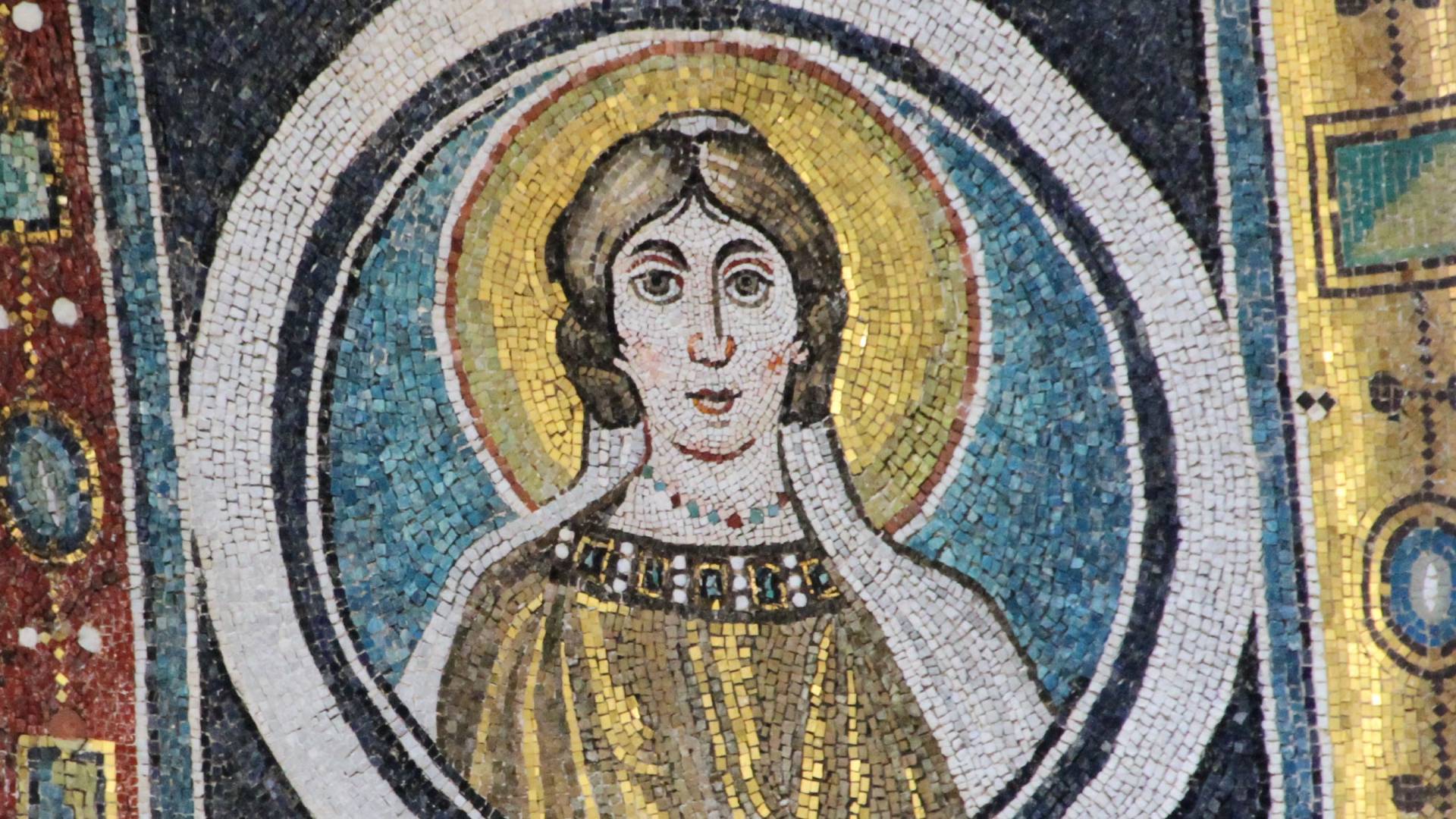

Deacon-structing Church Mothers, part 1
Deacon Pedro
Monday, June 21, 2021

Mosaic depicting St. Thecla in the 6th-century Euphrasian Basilica in Porec, Croatia. Photo credit: Shesmax on Wikimedia Commons, cropped and used under the terms of license CC BY-SA 3.0
For the last months we’ve been looking at the men who we refer to as Church Fathers. These are theologians who lived in the early Church and who, for one reason or another, have been influential in helping establish the doctrinal foundations of our Faith. The period they lived in is called the “Patristic Era”, which extends from the 1st century, with some of the people who learned the Faith from the Apostles, to around the 8th century.
In part 1, we learned about the Apostolic Fathers, those who learned the Faith from the Apostles themselves. In part 2, we learned about the Eastern Fathers, those who wrote in Greek; Part 3 was about the Western Fathers, those who wrote in Latin. Part 4 was about the Syriac Fathers, who wrote in Syriac. Last week we learned about the Desert Fathers. Though not prolific writers like some of the others, they were influential in establishing the practices that led to monasticism.
It is disappointing to learn that among these “Fathers” there are no “Mothers” who were influential in developing Church Doctrine. However, in my research I found that there were many women who were active and influential in the Church at the time, but sadly, either they were not great writers or their writings were not preserved. We know that at the time, especially in the first five centuries AD, women’s role in civil society was restricted, and therefore, it would have also been restricted within the Church.
This is why Patristics does not include any women. There is evidence of women having the role of deaconesses, but it’s not clear if they were the wives of deacons or if they were ordained. It’s also not clear if they were widows who were not able to re-marry (or chose not to) or if they were somehow consecrated as virgins. [You may be interested in reading my blog posts about women deacons.] But if any of them were writers, those writings have not been preserved.
I was, however, able to find several women who were influential enough in their time to have been noted and remembered. They may not have been writers, but they were prolific evangelizers and bearers of the Good News. Many of them, in fact, are referred to as “Ammas” or Mothers and even “apostles”.
We know that several women followed Jesus and were considered disciples, most notably, Mary Magdalene (John 20:1, 11-18) and Mary and Martha, the sisters of Lazarus (Luke 10:38-42). There was also Mary, the wife of Cleopas (John 19:25), and Mary, the mother of James and Joseph (Matthew 27:56) – which may be the same person. The Gospels also mention Joanna and Susanna (Luke 8:1-3) and Salome (Mark 15:40).
The Book of Acts and the Letters of St. Paul also mention several women disciples: Rhoda (Acts 12:6-19), Lydia (Acts 16:14-15), and Damaris (Acts 17:16-34). Priscilla (also known as Prisca, the wife of Aquila), who was a leader of a house church (Acts 18:1-28); Junia (Romans 16:7), Julia and Nereus’ sister (Romans 16:15). Another Mary (Romans 16:6), Demas (Colossians 4:14), and Tryphena and Tryphosa, who “work hard in the Lord” (Romans 16:12). Paul also mentions Euodia and Syntyche (Philippians 4:2-3), Apphia (Philemon 2), and Nympha (Colossians 4:15).
Later writings mention other noted women. One of them is Thecla, who heard St. Paul preach in Iconium and was converted. She rejected her betrothed husband, was condemned to death twice, and twice was miraculously spared. The story of her conversion and persecution is preserved in the Acts of Paul and Thecla. It also describes how she lived the life of a missionary apostle and lived in a cave for decades, where she died as a martyr at age 90. Her other adventures, miracles, and healings are described in The Life and Miracles of Thecla. Both Gregory of Nazianzus and Macarius the Great refer to her in their writings. The Eastern Catholic Church calls her an “apostle and protomartyr among women” and “equal-to-apostles in sanctity”. You can visit her tomb in that very cave at the Aya Tekla Church in Turkey.
Tradition holds that Irene of Macedonia was the daughter of a king and was converted and baptized by St. Timothy. The Life of St. Irene describes her as a successful evangelist who is said to have converted 10,000, “preaching about Christ and working miracles, healing the sick”. A longer narrative of her life describes her as an apostle who baptized, led prayer, conducted exorcisms, and performed miracles and cures, even raising her own father from the dead!
Another woman evangelizer is Nino, a relative of St. George, from Cappadocia, who is said to have evangelized the whole of Caucasia Iberia (present-day Georgia) in the fourth century. The Conversion of K’art’li, which tells the story of the Christianization of Georgia, has Nino describing her own anointing by the Patriarch of Jerusalem, who blessed her and sent her to “preach Your divinity, so that she may spread the good tidings of Your resurrection”. She is also called an apostle and the “joy of the Son of God”. Nino is said to have preached and baptized the whole region, including the queen and king, who was healed of blindness after praying to “Nino’s God”.
A few weeks ago, in writing about the brothers Sts. Basil, Gregory of Nyssa, and Peter Sebaste, I mentioned Macrina the Elder, as she was their grandmother. St. Basil writes that she learned from St. Gregory of Neocaesarea and in turn passed on these teachings to her grandchildren in the 3rd century. I guess we can say that she was instrumental in the formation of the Cappadocian Fathers!
Her granddaughter, and older sister to Basil, Gregory, and Peter, is Macrina the Younger. St. Gregory of Nyssa writes in the Life of Macrina that his sister was his teacher and describes her sanctity, choosing to study scripture and sacred writings over any other studies. Gregory credits her for teaching him the “spiritual reality of the Resurrection”. It is clear that this was a saintly family that has greatly influenced the whole of the Church thanks to the efforts of one holy grandmother.
One of the few Christian women in the early Church whose writings still remain is Proba, as she was a poet – perhaps the earliest Christian woman poet whose work still exists. Proba, living in the early 4th century, came from a prominent pagan Roman family and converted as an adult. She seems to have had a devotion to the third century saint Anastasia, as she and her husband are both buried at the Basilica of St. Anastasia in Rome (another woman saint in the early Church who is mentioned in Eucharistic Prayer I). Proba wrote the Cento Vergilianus de Laudibus Christi (A Virgilian Cento Concerning the Glory of Christ), a poem comprised of verses from the works of Virgil, re-ordered to form a poem – 694 lines – that tells Old and New Testament stories, focusing mainly on the life of Christ. The poem was highly popular in its time and was used in schools to teach Christianity. Isidore of Seville referred to Proba as “the only woman to be ranked among the men of the Church”.
I discovered that there is no lack of women saints and martyrs in the early Church. There are only a few, all martyrs, mentioned in Eucharistic Prayer I: Felicity, Perpetua, Agatha, Lucy, Agnes, Cecilia, and Anastasia. Almost none are remembered for their writings. Still I believe that their witness and lives can be said to have been formational for our Church.
Come back next week and we’ll look at some more prominent Christian women in the 2nd and 3rd centuries.
 Every week, Deacon Pedro takes a particular topic apart, not so much to explore or explain the subject to its fullness, but rather to provide insights that will deepen our understanding of the subject. And don’t worry, at the end of the day he always puts the pieces back together. There are no limits to deaconstructing: Write to him and ask any questions about the faith or Church teaching: [email protected]. Follow him on Facebook, Twitter and Instagram.
Every week, Deacon Pedro takes a particular topic apart, not so much to explore or explain the subject to its fullness, but rather to provide insights that will deepen our understanding of the subject. And don’t worry, at the end of the day he always puts the pieces back together. There are no limits to deaconstructing: Write to him and ask any questions about the faith or Church teaching: [email protected]. Follow him on Facebook, Twitter and Instagram.
 Every week, Deacon Pedro takes a particular topic apart, not so much to explore or explain the subject to its fullness, but rather to provide insights that will deepen our understanding of the subject. And don’t worry, at the end of the day he always puts the pieces back together. There are no limits to deaconstructing: Write to him and ask any questions about the faith or Church teaching: [email protected]. Follow him on Facebook, Twitter and Instagram.
Every week, Deacon Pedro takes a particular topic apart, not so much to explore or explain the subject to its fullness, but rather to provide insights that will deepen our understanding of the subject. And don’t worry, at the end of the day he always puts the pieces back together. There are no limits to deaconstructing: Write to him and ask any questions about the faith or Church teaching: [email protected]. Follow him on Facebook, Twitter and Instagram.Related Articles:
<<













